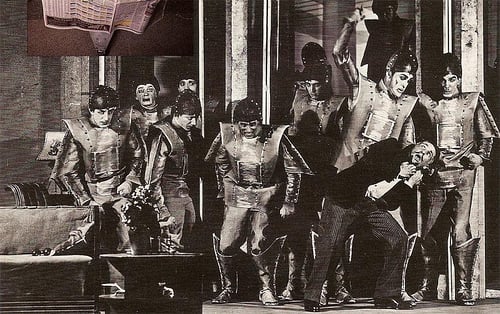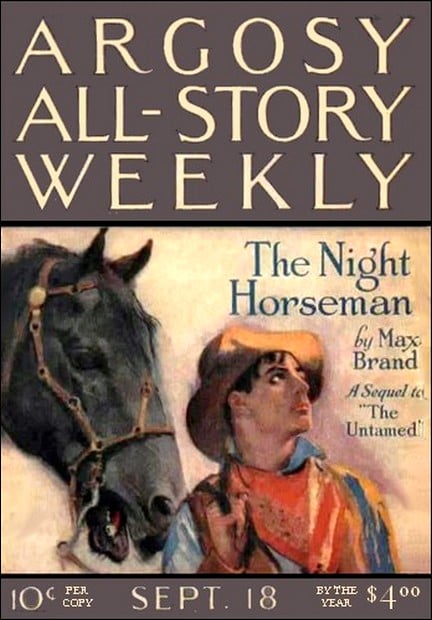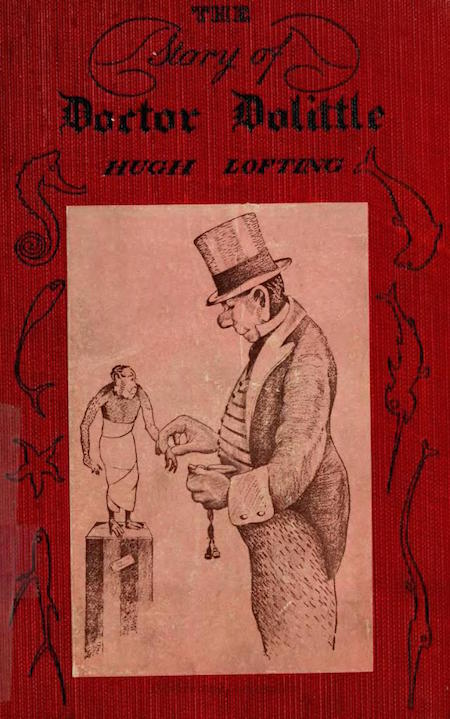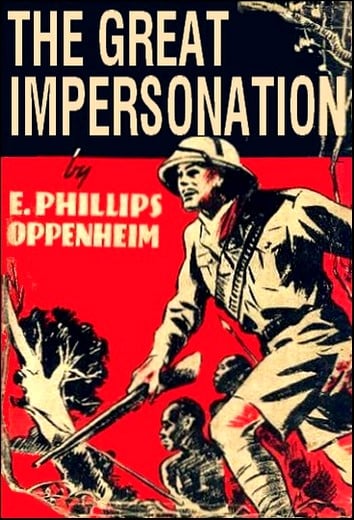10 Best Adventures of 1920
By:
August 28, 2015
Ninety-five years ago, the following 10 adventures — selected from my Best Nineteen-Teens Adventure list — were first serialized or published in book form. I urge you to read them immediately.
The following titles are listed in no particular order.
- Karel Čapek’s Radium Age science fiction play R.U.R.: Rossum’s Universal Robots. Čapek, a brilliant Czech litterateur, satirized the capitalist cult of efficiency, and expressed his fear of the unlimited power of corporations, in this play. On a mission from a humanitarian organization devoted to liberating the Robots (who aren’t mechanical; they’re the product of what we would now call genetic engineering), Helena Glory arrives at the remote island factory of Rossum’s Universal Robots. She persuades one of the scientists to modify some Robots, so that their souls might be allowed to develop. One of these modified Robots issues a manifesto: “Robots of the world, you are ordered to exterminate the human race… Work must not cease!” Chaos ensues. Fun fact: R.U.R. (w. 1920, performed 1921) gave the world the term “robot,” which the author’s brother, Joseph, coined as a play on the Czech term for unremunerated labor.
- John Dos Passos’s WWI novel One Man’s Initiation — 1917. An idealistic young American serving as a volunteer ambulance driver in France learns of the fear, uncertainty, and camaraderie of war. Not an adventure novel, exactly, because Dos Passos’s project was one of de-glamorization. But it’s an exciting story drawing upon the author’s experiences as a member of the French ambulance service; he wrote it in Europe after having been demobilized. Fun fact: This is Dos Passos’s first novel. He is best known for his U.S.A. trilogy, which consists of the novels The 42nd Parallel (1930), 1919 (1932), and The Big Money (1936). Jean-Paul Sartre referred to Dos Passos as “the greatest writer of our time.”
- Jeffery Farnol’s swashbuckling adventure Black Bartlemy’s Treasure. YA fantasy author Eoin Colfer has called this one of his favorite books, and I’ll reproduce Colfer’s synopsis of the plot: “It tells the story of Martin Consinby, who is sold into slavery on a Spanish galleon by the very man who murdered his father, and then – Oh, Cruel Fates! – falls in love with his tormentor’s daughter. As if life wasn’t complicated enough, he sniffs a rumour of the whereabouts of the infamous Black Bartlemy’s treasure, and it’s off to the Spanish Main we go.” Fun fact: Along with Georgette Heyer, Farnol is credited with founding literature’s Regency Romance genre.
- Baroness Emma Orczy’s Scarlet Pimpernel adventure The First Sir Percy. In this prequel to Orczy’s much better-known adventure novel, The Scarlet Pimpernel (1905), Sir Percy Blake — ancestor to the Scarlet Pimpernel — has just married Gilda Beresteyn (the wealthy Dutch merchant’s daughter whom he’d rescued from a kidnapper in the 1913 novel, The Laughing Cavalier) when he learns that the troops of the Archduchess Isabella (of Spain) are about to invade the Netherlands. A potboiler.
- Max Brand’s Whistling Dan Barry western adventure The Night Horseman. This is the second of three Whistling Dan Barry books serialized in the pulp fiction magazine Argosy. No white-hat good-guy, Barry is a feral figure — more comfortable in the wilderness than in town, more in tune with his animal companions than with humankind. (When a character in this story tries to explain Barry to an outsider, he says it’s a strange story: “It’s about a man and a hoss and a dog. The man ain’t possible, the hoss ain’t possible, the dog is a wolf.”) In this novel, considered one of the best Westerns ever, Barry is embroiled in a revenge duel to the death with the fearsome mountain man Mac Strann; meanwhile, he is sought by Kate, his foster-father’s daughter, who loves him — and whose love might be Barry’s only link to civilization. Fun fact: Writing as “Max Brand” (among other pen names), Frederick Faust dominated the pulp Western fiction field from the end of WWI (when he replaced Zane Grey, who had moved on from pulps to upscale magazines) until his death as a journalist on the Italian front in WWII. He also wrote a 1937 cowboys-and-aliens sci-fi novel, The Smoking Land.
- Edward Shanks’s Radium Age science fiction adventure The People of the Ruins. A proto-Idiocracy satire on H.G. Wells’s utopian novels. Trapped in a London laboratory during a worker uprising in 1924, ex-artillery officer and physics instructor Jeremy Tuft awakens 150 years later — on the eve of a new Dark Age! England has become a neo-medieval society whose inhabitants have forgotten how to build or operate machinery. Though he is at first disconcerted by the failure of his own era’s smug doctrine of Progress, Tuft eventually decides that post-civilized life is simpler, more peaceful. That is, until northern English and Welsh tribes threaten London — at which point he sets about reinventing weapons of mass destruction. Fun fact: “The first of the many British postwar novels that foresee Britain returned to barbarism by the ravages of war.” — Anatomy of Wonder, Neil Barron, ed. (1976). Reissued by HiLoBooks.
- Hugh Lofting’s children’s adventure The Story of Doctor Dolittle. When Polynesia, a parrot, teaches Puddleby-on-the-Marsh’s Dr. Dolittle to speak the languages of animals, he becomes world-famous. Importuned by African monkeys suffering from an epidemic, Dolittle and several of his closest animal friends — including Polynesia, the pig Gub-Gub the pig, the dog Jip, the monkey Chee-Chee, the duck Dab-Dab, and the owl Too-Too — head for Africa. They are shipwrecked, and must travel across the African continent by land — encountering marvels (like the pushmi-pullyu, which has heads at opposite ends of its body) and hostile African natives. Fun fact: This is the first in a series of a dozen Doctor Dolittle adventures, including The Voyages of Doctor Dolittle (1922), Doctor Dolittle’s Circus (1924), Doctor Dolittle’s Caravan (1926), and Doctor Dolittle in the Moon (1928). In recent editions, jokes at the expense of native African characters have been bowdlerized.
- E. Phillips Oppenheim’s espionage adventure The Great Impersonation. Shortly before the outbreak of World War I, a dissolute English baronet who happens to look exactly like the military commandant of the colony of German East Africa attempts a mission impossible; it’s a mashup of A Tale of Two Cities and The Scarlet Pimpernel, with a little Martin Guerre action, as well. When Dominey, the baronet, returns to England from Africa, he seems strangely altered — but his wife, although she suspects he’s not himself, loves him. Meanwhile, the lover of the commandant also loves Everard — because she believes he’s not Everard. Fun fact: The book was a bestseller; it has been adapted as a movie three times.
- David Lindsay’s A Voyage to Arcturus. An adventurous Scot, Maskull, encounters a semi-divine trickster figure, Krag, who whisks him from Earth to the planet Tormance, orbiting Arcturus. Reality is fluid, on Tormance — which turns out to be less an actual planet than a kind of proving-ground of the soul. Each chapter introduces a new philosophical system, religious idea, and concept of the true nature of the world — and then, having persuaded Maskull (and the reader) to believe in these things, mocks us for doing so. (C.S. Lewis on Lindsay: “He is the first writer to discover what ‘other planets’ are really good for in fiction… To construct plausible and moving ‘other worlds’ you must draw on the only real ‘other world’ we know, that of the spirit.”) Maskull is tormented by Crystalman, who bedevils humankind with comforting illusions and false pleasures. Falseness, it transpires, is winning the war against truth; only Krug, who maintains his sense of humor, and who claims to be known on Earth as “Pain,” can hold his own in the fight. Maskull’s trials and tribulations release his authentic self: Nightspore, who must return to Earth and save more souls from Crystalman’s clutches! Fun fact: A Voyage to Arcturus has been described as Calvinist (because pleasure is rejected in favor of instructive pain), Gnostic, Nietzschean, and psychedelic.
- William Aubrey Darlington’s comic adventure Alf’s Button. The story begins in the trenches of WWI, during a lull in the fighting. Alf, a slow-witted private, gets stuck in the mud and rips his jacket; his new uniform, it transpires, has a button made from Aladdin’s lamp. His wishes begin to come true — though with a comical disconnect between fantasy and reality. When Alf orders the genie of the button to bring down a plane from a dogfight, the British plane is downed rather than the German; when he asks for a woman, the genie brings a society beauty to whom Alf can’t begin to speak. When Alf and his friend Bill get some leave, they magic up a country house in England which is decorated according to the genie’s taste: scantily-dressed houris scandalize the neighbors. Alas, the button is lost when a trench collapses on Bill. Fun fact: The author served in the trenches of WWI, and was wounded at Arras. The book was a best-seller at the time, and was adapted into more than one silent movie.










Let me know, readers, if I’ve missed any 1920 adventures that you particularly admire.
JOSH GLENN’S ADVENTURE LISTS: 200 Greatest Adventure Novels (1804–1983) | Best Adventure Novels (1984–2013, notes only) | 100 Best Radium Age Sci-Fi Novels (1904–1933) | 75 Best Golden Age Sci-Fi Novels (1934–1963) | 75 Best New Wave Sci-Fi Novels (1964–1983) | 75 Best Diamond Age Sci-Fi Novels (1984–2003) | 55 Best Scientific Romances (1864–1903) | Best 19th Century Adventure (1805–1903) | 101 Science Fiction Adventures | 70 Crime Adventures | 65 Fantasy Adventures | 61 Espionage Adventures | 40 Atavistic & Historical Adventures | 25 Frontier & Western Adventures | 20 Avenger & Artful Dodger Adventures | 20 Apophenic & Treasure Hunt Adventures | 20 War & Ruritanian Adventures | 18 Picaresque Adventures | 10 Robinsonade & Survival Adventures.
ALSO: BEST SIXTIES YA & YYA (1964–1973) | THE OUGHTS: 1904 | 1905 | 1906 | 1907 | 1908 | 1909 | 1910 | 1911 | 1912 | 1913. THE TEENS: 1914 | 1915 | 1916 | 1917 | 1918 | 1919 | 1920 | 1921 | 1922 | 1923. THE TWENTIES: 1924 | 1925 | 1926 | 1927 | 1928 | 1929 | 1930 | 1931 | 1932 | 1933. THE THIRTIES: 1934 | 1935 | 1936 | 1937 | 1938 | 1939 | 1940 | 1941 | 1942 | 1943. THE FORTIES: 1944 | 1945 | 1946 | 1947 | 1948 | 1949 | 1950 | 1951 | 1952 | 1953. THE FIFTIES: 1954 | 1955 | 1956 | 1957 | 1958 | 1959 | 1960 | 1961 | 1962 | 1963. THE SIXTIES: 1964 | 1965 | 1966 | 1967 | 1968 | 1969 | 1970 | 1971 | 1972 | 1973. THE SEVENTIES: 1974 | 1975 | 1976 | 1977 | 1978 | 1979 | 1980 | 1981 | 1982 | 1983. THE EIGHTIES: 1984 | 1985 | 1986 | 1987 | 1988 | 1989 | 1990 | 1991 | 1992 | 1993. THE NINETIES: 1994 | 1995 | 1996 | 1997 | 1998 | 1999 | 2000 | 2001 | 2002 | 2003. I’ve only recently started taking notes towards a list of the Best Adventures of the EIGHTIES, NINETIES, and TWENTY-OUGHTS. | Best Scottish Fabulists | Radium-Age Telepath Lit | Radium Age Superman Lit | Radium Age Robot Lit | Radium Age Apocalypse Lit | Radium Age Eco-Catastrophe Lit | Radium Age Cover Art (1) | SF’s Best Year Ever: 1912 | Cold War “X” Fic | Best YA Sci-Fi | Hooker Lit | No-Fault Eco-Catastrophe Lit | Scrabble Lit |
